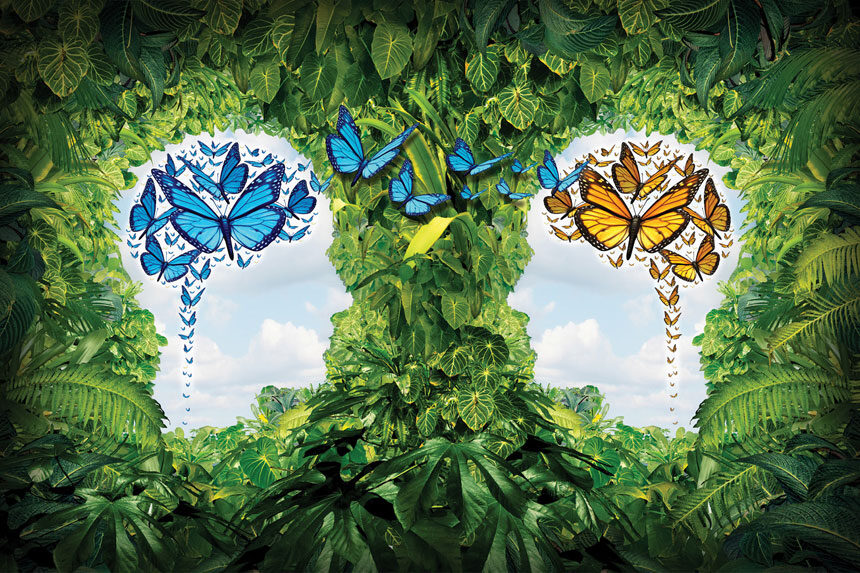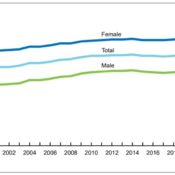“The test of a first-rate intelligence is the ability to hold two opposed ideas in mind at the same time and still retain the ability to function.”
—F. Scott Fitzgerald,
The Crack-Up
In my clinical work, I routinely worked with families who were in conflict. I remember this one vividly. An elderly man, the head of a three-generation family, suffered from advanced dementia. His adult son said he could cope with his father as long as he considered him a piece of furniture and did not bump into him. I will never forget that response or what followed. The little grandson spoke up immediately, telling his father that he was wrong, that his grandfather was still here. That little boy was my co-therapist that day.
He knew about both/and thinking, while his father did not. Both/and thinking means being able to hold two contradictory ideas in one’s mind at the same time — just as Fitzgerald wrote. This grandfather was gone, but he was still present — and alive. Here and yet gone. With such ambiguous loss, there is more than one possibility of truth, at least at that moment in time. It’s not the binary of either total presence or total absence. It’s both. People can be absent and present at the same time.
This way of thinking, however, can affect different people in different ways even in the same community, depending on social status and income. Sometimes we do not have the privilege of entertaining two options. With soldiers missing in action in the 1970s and the missing after 9/11, many families accepted death certificates for pragmatic and financial reasons. Yet, when I talked with them, their doubt was apparent. Most continued to say, “They’re probably dead” and “maybe not.”
When we think about the loss of a family member or friend as both/and, we may be reminded of dialectical thinking, which means holding both a thesis and antithesis but eventually reaching a synthesis or blending of those two opposing facts. With ambiguous loss, however, such opposing ideas may never blend and synthesize. This lack of having one precise answer is especially challenging for those who seek perfection.
Many of us have been trained to do just that: find the exact solution. While we may prefer such success, there are times, now and then, when there is no perfect solution. Some losses remain unclear forever, so we live with doubt.
It is important to know, therefore, that both/and thinking is not precisely the same as dialectical thinking. Dialectical thinking assumes an eventual merging of the two opposing ideas, but this cannot happen with losses that remain ambiguous. We may wish for synthesis, but it might never happen. Rather than waiting for some resolution, then, we use the ongoing tension of conflicting ideas to provide the momentum to move us forward toward adaptation and change — living life in a new way without the lost person.
While absolute thinking divides people, both/and thinking can show us what we have in common. In this commonality lies the possibility of shifting to a middle ground. Some stress remains, but balancing two conflicting ideas in your mind at the same time is less stressful than continuing to search for one perfect solution.
This way of thinking is more fluid, less absolute, and thus closer to the truth of ambiguous loss. It helps us find meaning enough to live with losses that have no apparent or immediate solution — like with the pandemic. But, even after this pandemic, there will continue to be physical and psychological losses as well as unanswered questions about death. This is not just from such extremes as war and plague, but simply from the stress of everyday life.
The both/and way of thinking is not appropriate for every situation of loss. In competitive games and financial matters, for example, there is no ambiguity. It’s either win or lose, gain or loss, success or failure. But in human relationships, and the loss of someone we love, such binaries won’t help us find peace. We are more likely to find it in the middle ground, that gray area in between each extreme.
During this pandemic, the stress of ambiguity was evident everywhere — from the pressure to change one’s routines and ways of working to the denial of COVID-19. Perhaps the most stressful was the politicization of those who refused to wear masks versus those who did and still do. As absurdity and rationality were at odds, our stress levels rose to crisis levels and immobilized us.
Regardless of what our disagreements were about how we saw loss during the pandemic, it still benefits us to manage our frustration and stress. We do this by continuing to use both/and thinking: I am both leaving home to go to work and spending time with my kids; I am both hungry for alone time and for social contact; I both disagree with my neighbor and continue talking with him; I am both stressed with a world weariness and also optimistic that things are slowly getting better.
When faced with problems right now that have no solution, we have to manage the stress they cause. Loss of our freedom to do as we please requires change, and change is stressful, especially when it wasn’t our idea. The core idea is that we can cope if we know what the problem is, have enough resilience to withstand the stress, and can balance our individual needs with a concern for others.
When faced with a problem that can’t be changed, at least right away, we can change our way of thinking because that’s all we can change. Instead of absolute thinking, we shift to both/and thinking. This is resilience — being open to change; being able to hold two opposing ideas in your mind at the same time, as F. Scott Fitzgerald wrote. Doing this is immensely useful when some outside force is wearing us down.
Consider the case of family caregivers. Today, millions of women, men, and teenagers are taking care of family members who have a terminal illness, a physical or psychological ailment, or some disability. Such illnesses or conditions become the dominant stressor for that family and alter every aspect of their routines and way of life. Whether it’s taking care of an elderly parent, a terminally ill partner, or a child with a serious illness, it’s another version of what we all felt with COVID-19 — our lives are dominated by an outside force. When illness controls our lives, or the lives of those we care for, we can’t always have our way. Parents of newborns and caregivers of frail elders all know the feeling.
To maintain their own health, caregivers learn early about the need for both/and thinking. In groups, they learn to externalize the blame to the illness or condition that caused the need for care, and then find the middle ground. “I will both care for my loved one and take care of myself.” This is not an easy task. In my own experience of caregiving for several years, I learned it was easier to write a book about caregiving than to do it. My empathy for family caregivers definitely grew.
A distraught man in a caregiving group once told me he was at his wits’ end taking care of his wife for over a year. She had Alzheimer’s disease. He was retired but had given up his Thursday afternoon golfing with his friends to do caregiving. I asked why he didn’t continue his Thursday afternoon off. Was it cost? No, he said. It was his guilt. He thought it was selfish to want some time off with his friends. What would people say? My recommendation: Take Thursdays off; golf with your friends. You can both be a good caregiving husband and take care of yourself. Paradoxically, taking time off is a gift to your ill wife; she will have a happier and healthier caregiver and husband.
Even when this pandemic is over, we will not have closure. Loss has left its mark on us and changed the ways we think and live. The novel coronavirus has both taken from us and given us something new. For me, that is the humility of knowing once again that I am not always in control.
Pauline Boss, Ph.D., is emeritus professor at the University of Minnesota. Widely recognized for her groundbreaking research on what is now known as the theory of ambiguous loss, she is the author of Loss, Trauma, and Resilience.
Reprinted from The Myth of Closure by Pauline Boss. Copyright © 2022 by Pauline Boss. With permission of the publisher, W.W. Norton & Company, Inc. All rights reserved.
This article appears in the March/April 2023 issue of The Saturday Evening Post. Subscribe to the magazine for more art, inspiring stories, fiction, humor, and features from our archives.
Become a Saturday Evening Post member and enjoy unlimited access. Subscribe now




Comments
Is the picture of the two heads with butterflies inside supposed to depict two opposed view? Confused because according to the article, both views should be in the same mind.